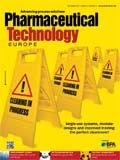Contamination: Invisible And Airborne
Pharmaceutical Technology Europe
Millions of pounds worth of products are at risk if contamination occurs in a cleanroom environment. According to an independent consultant (Cleanroom Management Associates Inc) for our company, contamination from personnel and equipment, such as wheeled carts and tanks, is a major concern in cleanrooms and controlled environments.
Millions of pounds worth of products are at risk if contamination occurs in a cleanroom environment. According to an independent consultant (Cleanroom Management Associates Inc) for our company, contamination from personnel and equipment, such as wheeled carts and tanks, is a major concern in cleanrooms and controlled environments.

Mark Dalziel. Managing director at Dycem Ltd
The consequences of contamination are severe. A single microbe in a batch of aseptic drugs could cause the entire batch to be quarantined or scrapped, leading to supply shortages, financial consequences, product recalls, FDA warning letters or even company shutdown in the worst case scenario.
High levels of air-borne contamination can lead to microbial corruption of cleanroom surfaces. By their very nature, the movement of airborne contaminants is volatile, which makes detection and prevention measures difficult. Contaminants are generated by people, process, facilities and equipment, and must be continually controlled and removed from the air.
Particles outside critical areas are a potential problem because they are not easily detectable, particularly small, light, invisible particles. Even loose particles that settle on the floor can be easily crushed into very small particles and redistributed back into the air due to vortices created by movement. These airborne particles become suspended in the air and get carried into the critical area where they present a potential hazard. Such particles are difficult to control because they are hard to see with the naked eye.
Contamination control
An effective contamination control regime should be put in place. ISO cleanroom standards recommend and cGMP necessitates that the introduction of particles into critical areas is minimised.
Effective contamination control requires a progressive zonal approach. Areas that are critical to maintaining cleanroom zones are entrances and exits; any areas used or inhabited by personnel, particularly gowning and staff changing areas and airlocks. Organisations also need to monitor and ensure that effective decontamination measures are in place in any areas where equipment, trolleys or tanks are moved.
All critical areas should also be sampled for particulates. Particles can be viable or non-viable, made from different materials, come from different places and travel large distances. There are two main types of contamination:
- external—gross atmospheric contamination, which can infiltrate a facility
- internal—the human body can generate 5–10 million skin, hair, dirt, and clothing particles every minute.
One of the most effective ways to minimise airborne contamination is to focus on the design of the cleanroom; all processes should be implemented with the reduction of airborne particles in mind.
Regulators and other professional bodies such as the International Society for Pharmaceutical Engineering (ISPE) recognise the importance of controlling contamination and implementing an effective contamination control flooring system. Flooring used in critical areas can be one of the most effective ways of reducing all contamination whether it’s foot, wheel or airborne, since the majority of contaminants enter the cleanroom at or near floor level. Unprotected flooring enables contaminants to be picked up on shoes and on the wheels of carts where they are tracked into the critical area. Here, there is a risk of them being redistributed back into the atmosphere.
Specialised flooring solutions can vastly reduce contamination risks. For example, polymeric flooring embeds particulates within its cellular structure, rather than binding it with surface adhesive as is done with peel-off mat flooring products. Peel-off mats have a surface area that is on average five times smaller than polymeric flooring, which doesn’t allow the three full wheel rotations necessary to decontaminate wheeled traffic. In addition, peel-off mats are also prone to wrapping around wheels of trolleys and carts making it impossible to control cross contamination in corridors.
Conclusion
In general, it’s important to consider the following:
- Space is important. Contamination on feet and wheels come in multiple layers and varying sizes, requiring multiple steps for complete decontamination. Effective decontamination needs at least six footfalls, three for each foot, or three full wheel rotations when using polymeric flooring. Companies that don’t allocate enough space to their cleanroom decontamination zones may be running unnecessary risks that can quickly impact on production and yield.
- Permanent solutions offer the most effective controls. Temporary/peel-off flooring measures that have to be regularly changed cannot combat airborne contamination. As soon as the flooring is lifted to be changed, all the contaminants on the floor will instantly become airborne and this creates a potentially damaging cycle of repeated airborne contamination.
- Inadequate cleaning procedures are a common pitfall. Companies should look carefully at ongoing cleaning and maintenance to ensure optimum contamination control measures are in place at all times.

Drug Solutions Podcast: A Closer Look at mRNA in Oncology and Vaccines
April 30th 2024In this episode fo the Drug Solutions Podcast, etherna’s vice-president of Technology and Innovation, Stefaan De Koker, discusses the merits and challenges of using mRNA as the foundation for therapeutics in oncology as well as for vaccines.